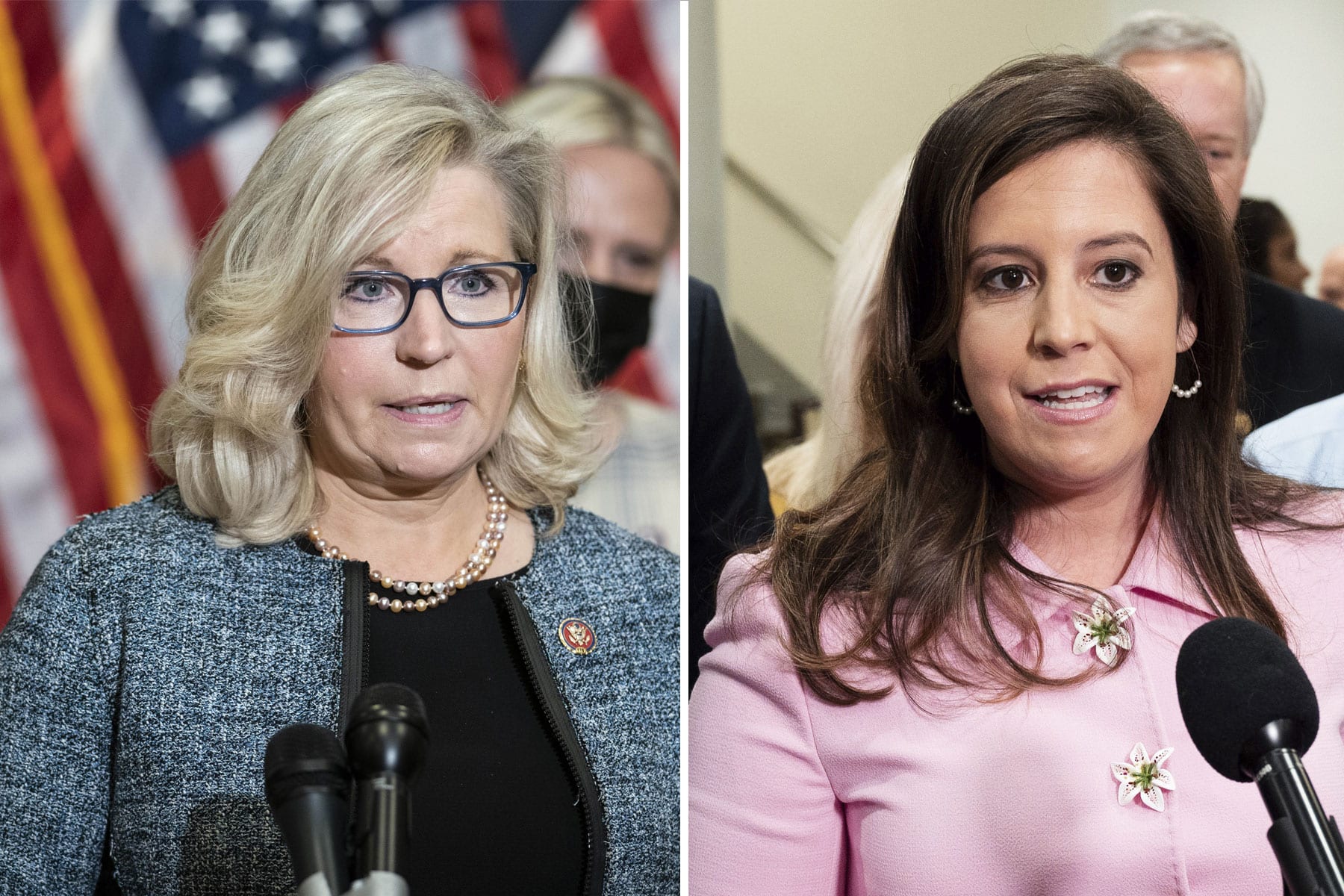Few career arcs in Washington better illuminate what it takes to survive and thrive in Donald Trump’s remade Republican Party than those of Liz Cheney and Elise Stefanik in the House of Representatives.
Cheney, 54, is a national security hawk who represents Wyoming’s only congressional district and who forewent seeking an open Senate seat last year to remain the third-ranking member, and only woman, in Republican House leadership. Her colleagues on Wednesday removed her from that post after both of the men above her said they had lost confidence in her ability to lead.
Stefanik, 36, is from a rural district in upstate New York that she flipped in 2014 after it had twice voted for former President Barack Obama. During her first two terms, she topped lists of the most bipartisan members of Congress and co-chaired a group of moderate Republicans. A vote on Cheney’s replacement could come as soon as this week, and party leaders have said Stefanik is better equipped to be conference chair and handle their messaging.
By backing Stefanik well ahead of Cheney’s removal, party leaders avoided what could become the potentially awkward dynamic of expelling the only woman from their leadership team at a time when the GOP is aiming to hold onto White, college-educated, suburban women in swing states and districts.
Both congresswomen were thought to be ascendant in the not-too-distant past. Cheney was poised to potentially become the first Republican woman to lead the House. Stefanik had secured support from leadership for a super PAC that aims to add women to the party’s ranks. Now, only one is, and it has nothing to do with their policy positions and everything to do with whether they defer to the election-fraud myth perpetuated by the former president.
Their point of divergence came on January 6, when there was a riot at the U.S. Capitol as lawmakers met to certify President Joe Biden’s valid victory in the 2020 election. Cheney said Trump “assembled the mob” that attacked the Capitol that day and certified the results. Stefanik went ahead with her plan to object to the certification, as did Reps. Kevin McCarthy and Steve Scalise, the other members of Republican leadership. Cheney went on to vote to impeach the president for his role; Stefanik, McCarthy and Scalise did not.
It’s not that Cheney voted for impeachment, or what she has said about the insurrection, that necessitated her ouster, those in her party have said. After all, McCarthy himself said shortly after the attack that Trump bore responsibility for it and should have denounced it more quickly. It’s what Cheney has said about the election results, and that she keeps saying it, that became a bridge too far for House Republicans.
“When Kevin McCarthy says that [Cheney] is off message for Republicans, he’s right, because they want their message to be that the 2020 election was stolen,” said Republican strategist Sarah Longwell, who is part of a group backing GOP lawmakers who voted for Trump’s second impeachment.
McCarthy said in a letter to his conference this week about Cheney’s recall that the party’s “driving focus would be taking back the House in 2022” and “each day spent relitigating the past is one day less we have to seize the future.”
“We are a big tent party,” he wrote, “and unlike the left, we embrace free thought and debate … but our leadership team cannot afford to be distracted from the important work we were elected to do and the shared goals we hope to achieve.”
But it is Trump, a relitigator-in-chief who incorrectly positions himself as a president-in-exile, who promises to keep the focus on the 2020 election as Republicans aim to retake the House in 2022. It is his near-daily missives from his Mar-a-Lago resort in Florida on the subject that have prompted Cheney to volley back.
“A former president, who provoked a violent attack on this capital, in an effort to steal the election has resumed his aggressive effort to convince Americans that the election was stolen from him. He risks inciting further violence. Millions of Americans have been misled by the former president, they have heard only his words, but not the truth,” Cheney said in a Tuesday night floor speech.
By campaigning to remove Cheney from her leadership post, and moving to install Stefanik in her stead, McCarthy and his fellow Republicans are making a gamble: They’re betting the House on Trump’s election myth. They could succeed. More than half of Republicans incorrectly believe that his 2020 loss resulted from some type of voter fraud. But, the type of independent and crossover voters they will need to win in swing districts in 2022 are less likely to be swayed by the former president’s argument.
Trump this week praised Stefanik’s work with E-PAC, the organization she started to support Republican women in their House primaries, saying the party needs a leader “who has experience flipping districts from Blue to Red as we approach the 2022 midterms, and that’s Elise!” While roughly one-third of the House candidates that E-PAC backed in 2020 flipped districts, just two did in districts rated by the nonpartisan Cook Political Report as slightly favoring Democrats.
And Cheney, even without her leadership post, shows little sign of fading quietly into the background. Some political prognosticators have already suggested that as Trump’s chief critic, she could be well positioned to challenge him should he run in 2024, when other Republicans, including former South Carolina Gov. Nikki Haley, have said they will hold back if Trump gets into the race.
“Remaining silent and ignoring the lie emboldens the liar. I will not participate in that. I will not sit back and watch in silence, while others lead our party down a path that abandons the rule of law and joins the former president’s crusade to undermine our democracy,” Cheney said on Tuesday.






